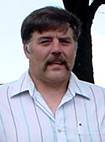David Johnson
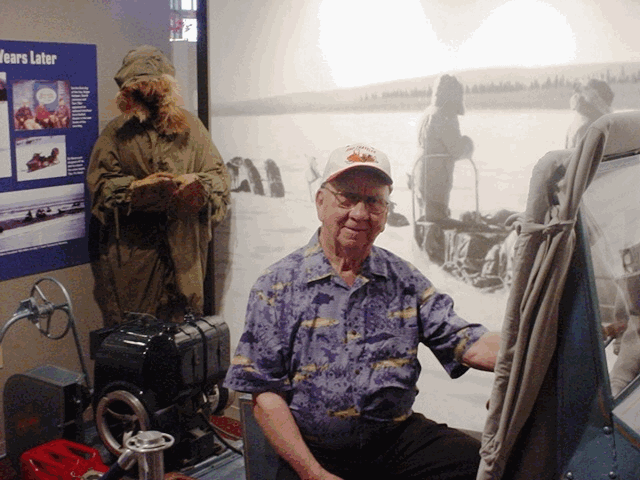
Captain of the Industry
It is not often that a reporter is able to interview a captain of an industry. Roseau resident David Johnson is one of the captains by any definition of the term, being the man to build the first snowmobile for sale in the United States, partner with Edgar and Allan Hetteen in founding Polaris and the only one of the original founders to be involved in Polaris from day 1 to the present.
I interviewed David at the Polaris Experience center, a fine museum of Polaris history located in Roseau near the Polaris factory. David was friendly, courteous and interesting, one wouldn’t know from listening that this was probably his 4,273rd interview and counting.
The interview started at the # 2 Polaris machine shown below. Saying, “We built it because we were basically lazy, we didn’t want to ski 20 miles to the cabin northeast of Salol,” David described the features of the early machine, similar to the number 1 machine he built. The machine was a conglomeration of new technology (for 1954) and old stuff pirated from other machines, the planetary geared steering from a Model T Ford was used as were the bumpers from a 1934 Chev (for skis), David was an equal opportunity scavenger. David said that ‘34 Chev owners in Roseau didn’t want to leave their vehicles unattended, they might come back and find the bumper gone.
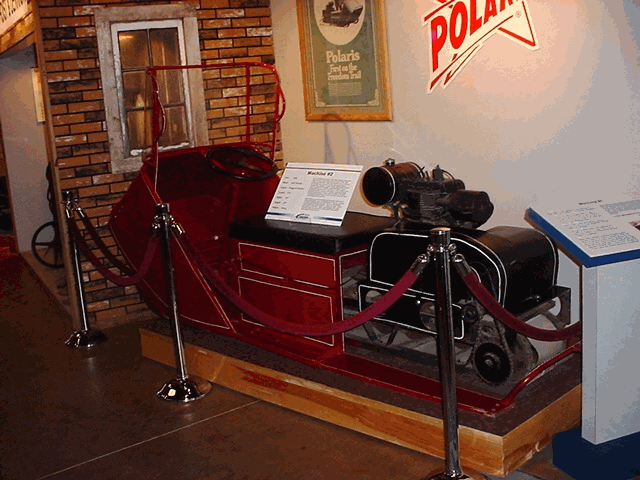
The track was custom built using roller chains with welded steel crossbars 16” on center and a loose canvas belt filling in the spaces, it was turned by a 10 horsepower Briggs motor bought at the hardware store. The clutching system was a simple belt tightener, the motor was mounted on a sliding platform which the operator moved by a lever to tighten the belt. The engine platform could easily be removed, to be able to take the engine indoors at night for easy morning starts. The machines attained a speed of a cool 8 mph, the first was sold to a local lumberyard operator who has the distinction of being the first Polaris test driver, only he didn’t get paid. The machine evidently sold with a maintenance and towing contract, David said that they had to rescue it on numerous occasions from hard to reach locations with hand towed toboggans when it got stuck or broke down. Perhaps this was Edgar’s idea of a company fitness program.
David described manufacturing conditions during the early 1950’s as tough. Steel was hard to get, the automobile industry got the best, Polaris had to buy remnants, the tolerances were poor. The shop also did automotive machine work, one of Allan’s responsibilities was crankshaft grinding on automobiles. They had a device that could machine the crankshaft while still in the engine, they built a special stall in the shop with a work area underneath like the modern day oil change shops, Allan would drop the oilpan and machine the damaged journals. Other early products of the company were straw choppers, grain and hay elevators, wooden boats, trailers, field sprayers, playground swings, garbage can stands, the company was apparently adept at building a host of items. David said that the first sprayers were built from used pipe, it was soon found that the rust would plug the nozzles so the defective booms were replaced with new ones, the old pipe was used in building the playground swings.
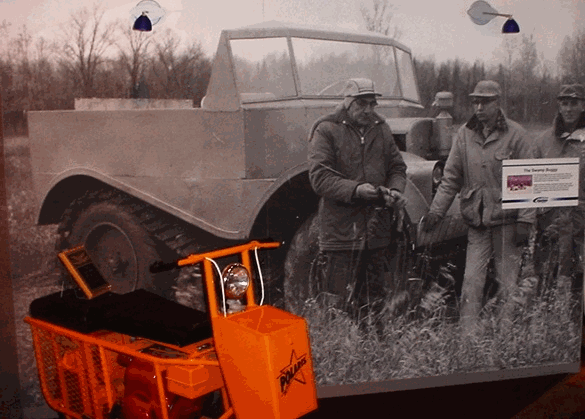 Throughout
the late 40’s and early 50’s, the three were building
contraptions for going into the hinterlands, the display shown to the
left display shows a neat all terrain vehicle called the Swamp
Buggy powered by a Wisconsin V-4, it had 4 wheel drive and a track
system turned by the back axle. The vehicle ended up in southern
Minnesota, David said he’s attempted to buy it back with no
success.
Throughout
the late 40’s and early 50’s, the three were building
contraptions for going into the hinterlands, the display shown to the
left display shows a neat all terrain vehicle called the Swamp
Buggy powered by a Wisconsin V-4, it had 4 wheel drive and a track
system turned by the back axle. The vehicle ended up in southern
Minnesota, David said he’s attempted to buy it back with no
success.At some point, Allan started trucking company product. David said that after Allen built machine number 2, it was sitting in his yard while he left on a delivery. Things were tight, Edgar needed to make payroll and an opportunity to sell the snowmobile arose so David and Edgar took a ½ ton pickup over, loaded up machine number 2, took it to the Northwest Angle and sold it. One wonders if Allan made sure prized possessions were under lock and key the next time he left for parts unknown.
Mike Hetteen, Allan’s son, soon joined us for the interview. He is at present a purchasing manager at Polaris, but is better known as husband of Janet, the lady who runs the Experience Center and gives plant tours. I asked about the partnership dynamics of the original three. Both said it was a good relationship, even after Edgar left and eventually started Arctic Cat.
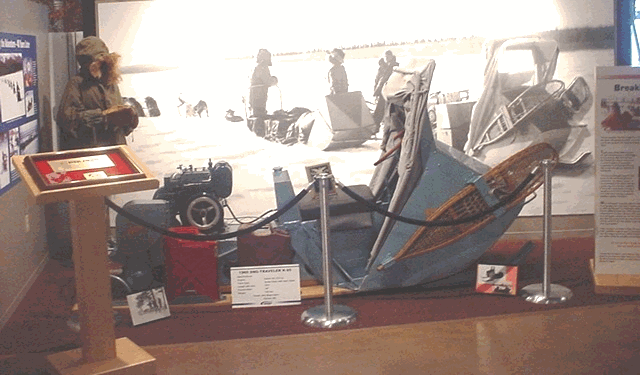 David
said that Edgar was the promoter and buyer, much of his time was spent
on the road either buying material and shop equipment or selling
product. (His Alaskan trip from Bethel to Fairbanks, memorialized in
the display at the experience center, was a landmark for the world of
snowmobiling. It put Polaris and snowmobiles on the forefront of
mechanical advances. Unfortunately, instead of returning to a
hero’s welcome in Roseau, the reception by some was evidently
somewhat chilly.) Edgar resigned from the board of directors and, after
spending a year or so in Alaska, started up Arctic Cat in nearby Thief
River Falls. David and Mike said that Hartz of the Grocery Store
Chain was Edgar’s financial backer for that venture.
David
said that Edgar was the promoter and buyer, much of his time was spent
on the road either buying material and shop equipment or selling
product. (His Alaskan trip from Bethel to Fairbanks, memorialized in
the display at the experience center, was a landmark for the world of
snowmobiling. It put Polaris and snowmobiles on the forefront of
mechanical advances. Unfortunately, instead of returning to a
hero’s welcome in Roseau, the reception by some was evidently
somewhat chilly.) Edgar resigned from the board of directors and, after
spending a year or so in Alaska, started up Arctic Cat in nearby Thief
River Falls. David and Mike said that Hartz of the Grocery Store
Chain was Edgar’s financial backer for that venture.I was curious, asked about the family Christmas Parties, was there by chance any friendly races between Edgar’s Arctic Cats and the Polarises? The closest to an answer I got was, “Edgar always said the races started when the second machine was built…”
I’d have to guess that on the way to the family’s cabin northeast of Salol at least once the latest and greatest from each got wrung out.
I asked Mike about the Allen Hetteen award given out by the International Snowmobile Hall of Fame. He said that Jerry Bassett, publisher of the American Snowmobiler, was instrumental in setting it up, it was meant for people who were important to the industry though not in the Hall of Fame.
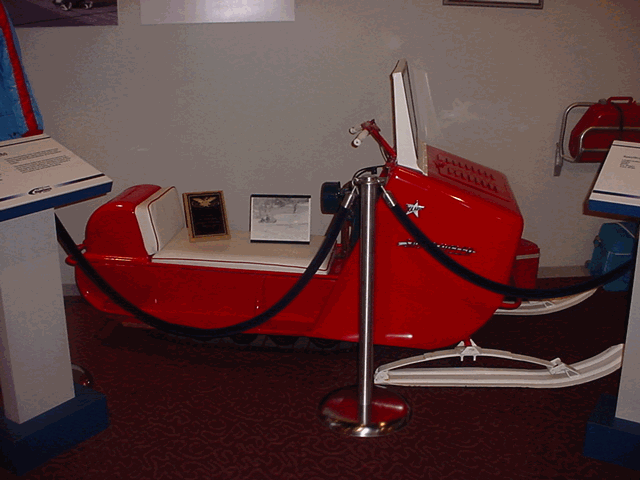 Allen
was president at one of the most trying times in Polaris history.
The newly designed Comet shown here was sold in 1964. Looking
pretty in the museum exhibit, the design that copied Ski Doo
didn’t work. David’s famous line is that, “Out
of 400 machines sold, 500 came back.” It was a tough time
for Polaris, but they didn’t give up, they met with their
creditors. They promised to pay them in full if they would supply them
with material to continue manufacturing, the suppliers agreed to supply
the needed materials, and Polaris paid them off.
Allen
was president at one of the most trying times in Polaris history.
The newly designed Comet shown here was sold in 1964. Looking
pretty in the museum exhibit, the design that copied Ski Doo
didn’t work. David’s famous line is that, “Out
of 400 machines sold, 500 came back.” It was a tough time
for Polaris, but they didn’t give up, they met with their
creditors. They promised to pay them in full if they would supply them
with material to continue manufacturing, the suppliers agreed to supply
the needed materials, and Polaris paid them off.David notes that Paper-Calmanson Steel was one of the suppliers that trusted Allan and Polaris for millions and was repaid and rewarded. Mike said, “What Dad said was what he did, and the suppliers knew that.”
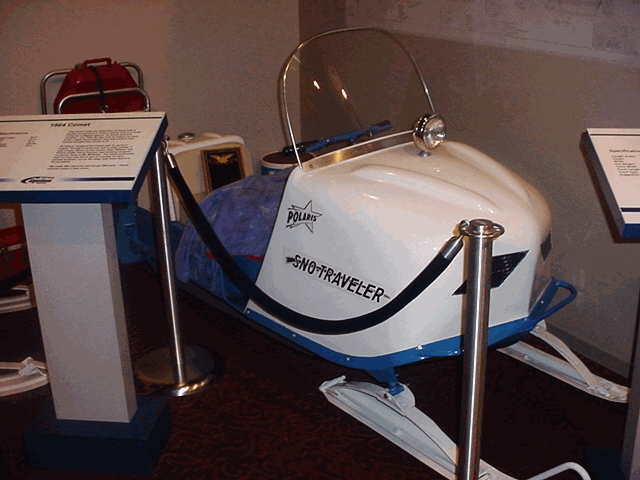 David
and Allan, knowing what they could do, designed the Mustang, shown here
in its display at the Experience Center, the machine that was first to
mount the engine ahead of the handlebars. It performed well, was
reliable and sold well. Of the engine forward design, David said,
“We told the customers it wouldn’t pull their necktie into
the carburetor like the rest of them.”
David
and Allan, knowing what they could do, designed the Mustang, shown here
in its display at the Experience Center, the machine that was first to
mount the engine ahead of the handlebars. It performed well, was
reliable and sold well. Of the engine forward design, David said,
“We told the customers it wouldn’t pull their necktie into
the carburetor like the rest of them.”David said that the most influential Polaris snowmobiles were the Colt and the Mustang and later the IFS (independent front suspension) Indy. I’ll note here that nearly all snowmobiles since the mid sixties have had independent leaf spring front suspensions, the difference with the Indy is that Polaris engineered a trailing link coil spring front suspension that they used pretty much unchanged for over 20 years. They’ve gone to a double A arm coil spring suspension now with the newer snowmobile designs.
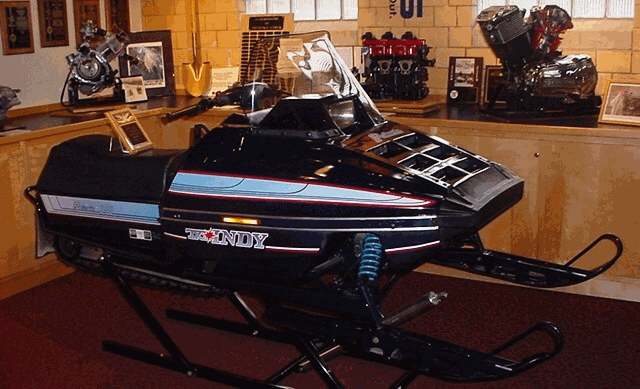 David
spoke with pride about the early Polaris employees, how, when times
were hard, the employees kept on working even if the paychecks were
late. When asked about specific innovations, the answer was
nearly always the same, industry leading advancements like hydraulic
brakes, Polaris clutches and the Indy suspension were all team efforts
at Polaris. The 1980 TXL Indy is shown here.
David
spoke with pride about the early Polaris employees, how, when times
were hard, the employees kept on working even if the paychecks were
late. When asked about specific innovations, the answer was
nearly always the same, industry leading advancements like hydraulic
brakes, Polaris clutches and the Indy suspension were all team efforts
at Polaris. The 1980 TXL Indy is shown here.David spoke some about Polaris’ involvement in racing as we were passing one of the racing sleds on display. Patting a suspension member, he said the knowledge gained racing was valuable, the components that broke down while they were racing were strengthened and the improved components used on the production machines. As we passed by the Colt 175 on display, David noted that the display machines were restored to nicer condition than when they were new.
I told David I’d like to photograph him on his favorite snowmobile in the exhibit, his quick choice was the Ranger from the Alaska trip display. Dave pointed out with admiration that Bessie Billberg had done the whole 1200 mile trip standing at the back of the sled towed by the machine. My camera battery died so I had to re-schedule, David graciously came back several days later to pose for the shot below.

David talked some about Polaris 4 wheelers, his personal model is a 500 Sportsman, one of the company mainstays. He says that Polaris has an edge in innovations and accessories, one of the Polaris mottos developed over the years is: “Design and build a machine such that once you have one, you can’t get along without it.”
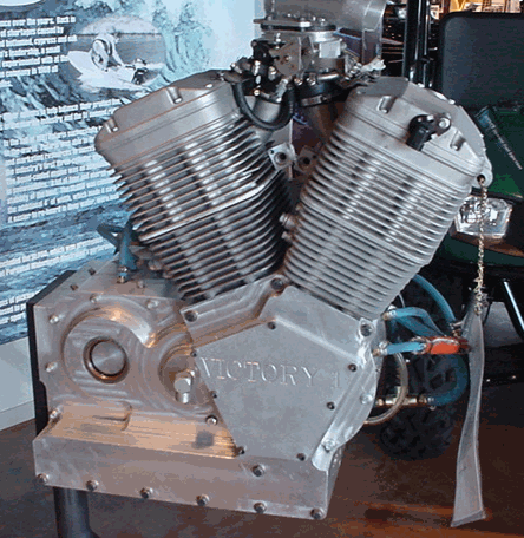 David
also pointed out the Victory motorcycle V twin engine on display,
noting the machined aluminum case of the first prototype model.
David
also pointed out the Victory motorcycle V twin engine on display,
noting the machined aluminum case of the first prototype model.He recounted a recent elk hunting trip near Rangely, Colorado where he said he was lucky enough to get an 800 pound elk, it was down a ravine and nearly dusk when they were done field dressing it. The guide had a Polaris Ranger 4x4 and took it down the ravine to where David and his hunting partners were, they loaded the elk in the back and all five got onto the rig and it capably hauled the whole bunch out of the ravine. Point proved.
The picture below shows a Ranger at the Experience Center similar to the one used on the elk hunt. The new RZR Ranger recently developed by Polaris is an extension of this capability, it won Baja on its first outing, truly another amazing chapter in the rich Polaris racing heritage.
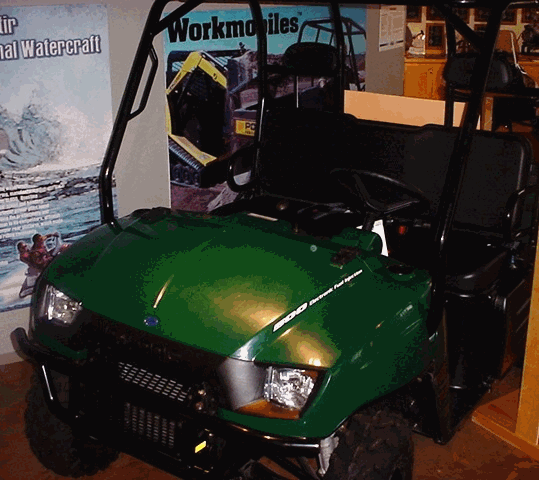 David
noted the Polaris tradition of being involved with the support
organizations, specifically the ATV clubs. Allan was instrumental in
this tradition, he was the first president of the International
Snowmobile Industry Association and led early Polaris safety education
efforts, providing safety education material to snowmobile clubs,
public service organizations, print media and broadcast media.
David
noted the Polaris tradition of being involved with the support
organizations, specifically the ATV clubs. Allan was instrumental in
this tradition, he was the first president of the International
Snowmobile Industry Association and led early Polaris safety education
efforts, providing safety education material to snowmobile clubs,
public service organizations, print media and broadcast media.David told me his personal snowmobile is a Polaris 600cc 4 stroke non-turbo touring model.
We left about the same time, after David examined my home built 4-wheeler in the bed of my SuperCab, notable in that the engine was a carbon copy of the Lauson engine on the little Snow Traveler in the experience center. David then jumped into his well used Chevy pickup and headed for the Northwest Angle.
I went back to the Experience Center and asked for a copy of the DVD Polaris had produced for the 50th Anniversary. I’d already read the Pioneers book written by Jerry Bassett in preparation for the interview. There was interesting footage in the DVD of the early contraptions and of David pulling a monster wooden lake cruiser out of the lake on a muddy landing with the Swamp Buggy. There were a couple of early pictures of the three founders standing in the shop, David’s lower face grimy, the upper face clean like he’d been wearing some gas welding cutting goggles. I saw later pictures of David testing some of the earlier machines, a Snow Traveler set up with wheels for summer use along with the trail bike. Edgar tells the story of David giving a demonstration ride on machine #2 and the throttle stuck, of David’s lightning quick reactions to push his rider out of the way to pull the plug wire off to stop the machine.
During the interview, David told the story of the Comet, the only time he really spoke of an effort in the first person, he said, “I didn’t build the track right, instead of cable, we used rods that went through the roller chains and through the rubber extrusions and were spot welded on each end of the rods, the rods and/or welds would break, it didn’t hold up.” He took responsibility for the mistake, in the cases of great success, he credited the team effort.
It takes some time for things to gel and a couple of days after the interview I was in my shop using the drill press and it came to me. I’ve met a couple of guys in my lifetime that were naturals when it came to turning a wrench or running a welding bead. They can look at a problem and figure out a way to get the job done. They are indispensable to the operation of a shop or a business. By any practical standard, they are self-taught engineers.
This is David Johnson. He started out in the shop, one of the indispensable ones, in time he told the engineers what to do, he finished as a Captain of the Industry.
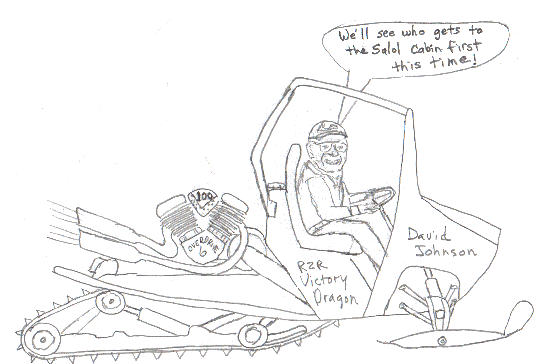
By Rob Crowe, Free Lance Reporter, Warroad Pioneer. Rob says: I’m a gearhead from way back. Mt first experience with a Polaris was riding my uncle’s 8 hp four stroke Montgomery Ward, a machine built by Polaris. I’ve owned several Polarises over the years including a 1975 Colt 340 SS and a 1977 440 Electra, my son owns several Polaris machines, including a Sportsman 500 ATV.
